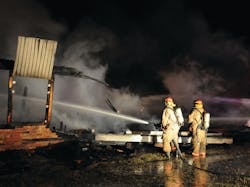Asking any homeowner to put a dollar figure on the “cost” of a fire is nearly impossible. How do you put a price on family heirlooms that have been lost forever? How to you put a price on precious photographs that will never be seen again? How do you put a price on the loss of a loved one? You can’t. A homeowner simply cannot put a tangible price on his or her loss. It is too personal.
Fire, however, is also a business. It is the business of firefightd, fire departments and fire associations like the U.S. Fire Administration (USFA) and the National Fire Protection Association (NFPA). As such, it is their business to determine the actual cost of a fire. In these tough economic times, everybody wants to cut back and save money. The best way to do that is to find out where the money presently spent is going, and then determine how to best cut back from there.
The NFPA recently released an updated report on the Total Cost of Fire in the United States. It can be seen from the report that the total cost of fire in 2010, adjusted for inflation, is 38 percent higher than in 1980, while its proportion of U.S. gross domestic product (GDP) has declined by roughly one-third.
However, both the total cost of fire and total cost as percentage of GDP have been roughly steady for the past several years. The total cost of fire for 2010 is estimated at $328 billion, or roughly 2.2 percent of U.S. GDP.
The complete total cost of fire is defined in this report as the sum of economic loss (e.g. property damage, business interruption), human loss (e.g. lives lost, medical treatment, pain and suffering), and the cost of provisions to prevent or mitigate the cost of fire (e.g. fire departments, insurance, and fire protection equipment and construction).
Surprisingly, economic loss (property damage) – reported or unreported, direct or indirect – represents only $14.8 billion of this total. The net costs of insurance coverage ($19.2 billion), the cost of career fire departments ($42.6 billion), new building costs for fire protection ($31.7 billion), other economic costs ($47.5 billion), the monetary value of donated time from volunteer firefighters ($140.7 billion) and the estimated monetary equivalent for the civilian and firefighter deaths and injuries due to fire ($31.9 billion), all are larger components than property loss.
Other key findings from the report:
- Although the core total cost of fire has increased by 45 percent since 1980 to total $108.4 billion, the economic loss due to fire decreased by 29 percent, totaling $14.8 billion.
- The total cost of direct property damages, reported or unreported, was $13.2 billion. This figure represents 89 percent of the economic loss. The other 11 percent represents indirect losses, such as business interruption.
- Building construction expenses needed solely for the purposes of fire safety and fire protection considerations totaled $31.7 billion.
- Human losses were estimated at $31.9 billion.
- Inflation-adjusted total cost increased by more than one-third (39%) since 1980, but has been roughly steady for the past several years.
- Total cost as a percentage of GDP has declined by roughly one-third since 1980, but has been roughly steady for the past decade.
It should be clear that most of the analysis supporting these estimates is soft and has wide bands of uncertainty. Nevertheless, the conclusion that fire has a tremendous impact on the way the U.S. uses its resources is indisputable.
In the report, author John R. Hall, Jr. says, “It is also clear that we have a dual interest in reducing U.S. fire losses – which include human losses that are among the highest per capita in the industrial world – and in seeking ways to achieve equivalent fire safety at lower costs, since the growth in total cost of fire has been led not by the fire losses but by the other cost components.” (See Table 1.) “This provides a clear indication of need for product innovations or other programs (e.g., residential sprinklers, educational programs) that can improve fire safety at the same or lower costs. It also shows the need for improved methods (e.g., models) for calculating fire performance and costs, so the implications of different choices can be considered and judged more comprehensively.”
You find and download the full report from the NFPA's web site.
Author's Bio:
Steven Shaw is the associate editor of Firehouse magazine, Firehouse.com and the Firehouse Limited Edition Tablet App.






